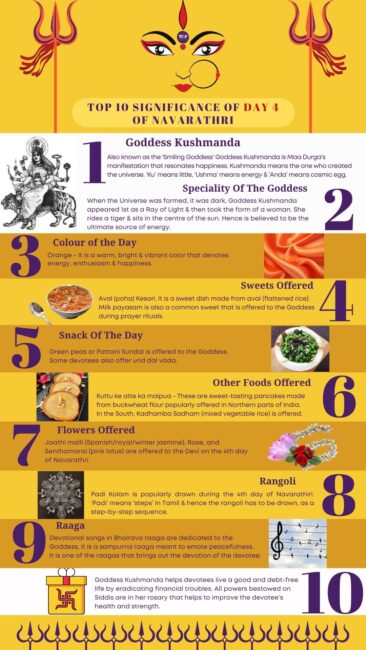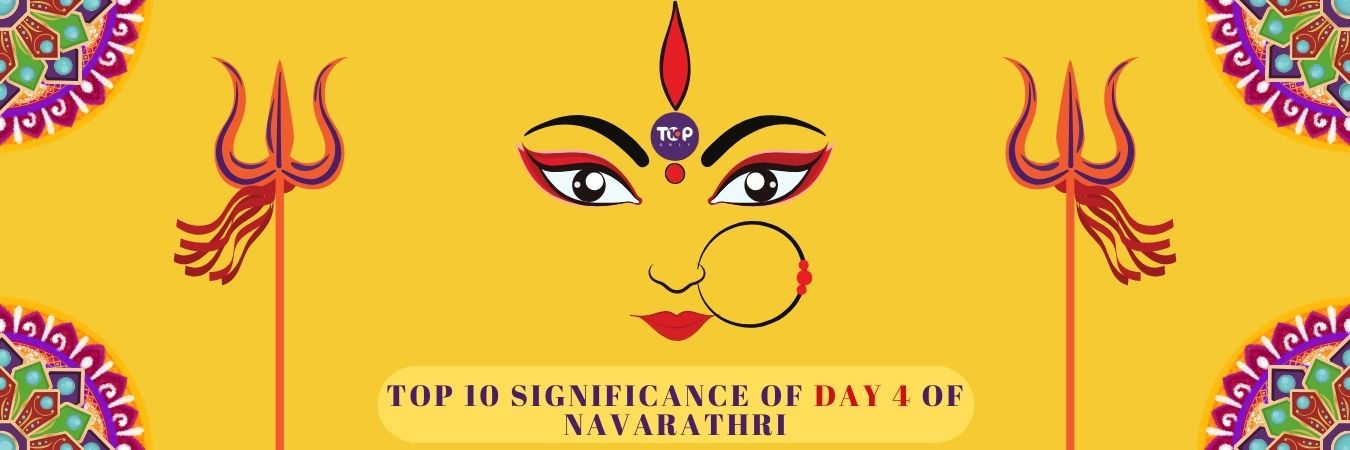Updated on: 13.09.2024

There is no better time for devotees to show the strength of their faith in the Goddess Maa Durga than on the nine auspicious days of the Navarathri Festival! The majestic manifestations of Devi Maa Durga invoke deep religious fervour in the hearts of the devotees and ultimately gives them the strength to fulfil the many rituals and pujas that they will have to perform during these nine days.
Top 10s Only presents a brief look at Day 4 of the Navarathri festival that will be celebrated on October 6, 2024 (Sunday).
If you’ve missed the top 10 significance of Day 3 of Navarathri, you can read about it once you finish checking out this article!
Significances Of Day 4 Of Navarathri
The significance of Day 4 of Navarathri lies in the story of Goddess Maa Kushmanda. As per the Navarathri day 4 Devi Katha (story or legend), initially, nothing existed in the universe and only deep darkness prevailed. Then, a ray of light appeared and brightened everything. Initially shapeless, this light began to take shape and took on the form of Goddess Maa Kushmanda. This divine Goddess then proceeded to create the planets, galaxies, the sun and stars, all by just flashing a little bit of her smile. She is believed to sit right at the centre of the sun and is said to be the ultimate source of powerful energy.
This fourth day of Navararthri is celebrated to remember Goddess Maa Kushmanda who created the universe we live in. Devotees pray on this day to be blessed with prosperity and success.
1. The Name Of Goddess Worshipped On Day 4 Of Navarathri
Day 4 of Navarathri is dedicated to Goddess Maa Kushmanda. She is one of the manifestations of Goddess Maa Durga. Goddess Maa Kushmanda resonates with pure joy and happiness and has often been called ‘the smiling Goddess’. Kushmanda means the person who created the universe. In her name, ‘Ku’ means a little, ‘Ushma’ means energy and ‘Anda’ means cosmic egg. As the Devi Maa Kushmanda has eight hands she is also called Ashtabhuja Devi.
This day is celebrated to remember the Goddess Maa Kushmanda who created the universe we live in. Devotees pray on this day to be blessed with prosperity and success.
2. The Speciality Of The Goddess Worshipped On Day 4 Of Navarathri
The Devi Maa Kushmanda is always depicted seated on a tiger. She holds a lotus, arrow, bow and kamandalam (sacred pot) in her four right hands. In addition, she holds a chakra (discus), gadha (mace), rudraksha mala (rosary) and a jar of nectar in her four left hands. Since Goddess Maa Kushmanda provides energy and direction to the sun and has the power to sit inside it, her body glows with its radiance. Her abode is in the heart chakra.
3. The Colour On Day 4 Of Navarathri
The Navarathri Day 4 colour is Orange. This warm colour signifies energy, enthusiasm and happiness. It also exudes positive energy and a vibrancy that matches the Devi, who is protective, charitable, brave and has the capacity to destroy evil. People are seen wearing this colour to mark the occasion.
4. The Sweets To Be Offered On Day 4 Of Navarathri
For Navarathri day 4, the prasadam is aval kesari. It is a sweet dish made from aval (flattened rice). Milk payasam is a also typical sweet offered to the Goddess Maa Kushmanda during puja rituals.
5. The Snacks To Be Offered On Day 4 Of Navarathri
On Day 4 of Navarathri tasty snacks like green peas or peanut sundal is prepared as part of the traditional rituals. Some devotees also offer urad dal vada to Goddess Maa Kushmanda. Both are yummy-tasting dishes to try.
6. The Other Food Items To Be Offered On Day 4 Of Navarathri
During Navarathri Day 4, devotees also prepare a dish called Kuttu ke atte ka malpua. These are sweet-tasting pancakes made from buckwheat flour. This food item is the main offering made to Goddess Maa Kushmanda, especially in North India. A dish called Kadhamba Saadham is also offered as Navarathri day 4 naivedyam. It is a delicious mixed vegetable rice dish and is the standard offering made to Goddess Maa Kushmanda in South India.
7. The Flowers To Be Offered On Day 4 Of Navarathri
Devotees use flowers such as jathi malli (Spanish/royal/winter jasmine), Rose, and Senthamarai (pink lotus) during the Devi aarti rituals. The Goddess Maa Kushmanda is welcomed into homes decorated with these beautiful flowers on Navarathri day 4.
8. The Rangoli On Day 4 Of Navarathri
Padi Kolams are a sight to behold on Day 4 of the Navarathri festival. ‘Padi’ means ‘steps’ in Tamil. Hence, the rangoli has to be drawn in a step-by-step sequence. It is made using ‘Atchathai’ – a mixture of rice, turmeric, and ghee. Before Navarathri day 4 aarti, Padi kolams are drawn by the devotees at the entrance of their homes to welcome the Goddess Maa Kushmanda.
9. The Raaga On On Day 4 Of Navarathri
During Navarathri day 4 Devi aarti, devotional songs are sung in Bhairava raaga. It is a sampurna raaga meant to emote peacefulness. It is one of the raagas that brings out the deepest sense of devotion of the devotee.
10. The Belief On Day 4 Of Navarathri
On Day 4 of Navarathri, Goddess Maa Kushmanda is adorned with wild turmeric (kasthuri manjal), scented oils, and rose water. In addition to this, handmade garlands made with turmeric pellets and pearls are placed around the neck of the Devi.
Praying steadfastly to Goddess Maa Kushmanda is believed to eradicate all the financial troubles of the devotee. It is said that her blessings enable the faithful to live a happy, prosperous and debt-free life. It is believed that praying to the Goddess Maa Kushmanda helps to improve the devotee’s health and vigour. There is also a belief that all the power bestowed on the Siddis is located in her rosary.
This concludes our look at the significance of the fourth day of Navarathri and Goddess Maa Kushmanda, who bestows her blessing through her benevolent smile!
Remember to comment about the rituals that you follow during this day.
Still seeking more information about various Navarathri traditions? Discover the customs associated with this magnificent festival by reading the Significance Of Day 5 Of Navarathri.


Pingback:Significance of Day 5 of Navarathri | Skandamata | Top 10s Only
Pingback:Navarathri Day 1 Significance - Maa Chandraghanta | Top 10s Only
Pingback:Navarathri Day 5 Significance - Maa Skandamata | Top 10s Only